Picture this:
the vibrant bustle of Algirós Market, a culinary haven where Chef Luis Castro unraveled the secrets of one of Spain's
most iconic dishes – paella.
 |
| Algiros Market |
 |
| Algiros Market |
The Valencia Club Cocina is located at Plaça de Sant Felip Neri, 6, Camins al Grau, 46021 València, Spain and is directly in front of the Mercado Algirós.
 |
| Chef Luis setting up for class |
 |
| Ready to begin |
My recent escapade at Valencia Club Cocina not only unveiled the art of crafting paella but also delved into fascinating culinary insights shared by Chef Luis Castro.
As I stepped into the culinary realm of Valencia Club Cocina, I was greeted by Chef Luis Castro, an expert chef for over 25 years. The chefs at Valencia Club Cocina are fluent in various languages and instantly dissolve any language barriers, setting the stage for an interactive and enjoyable cooking class. The class size on my appointed day consisted of three students and Chef Luis.
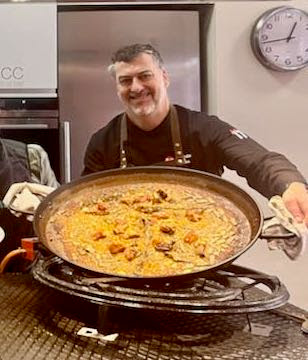 |
| Chef Luis |
The two to three hour paella cooking class wasn't just about mastering the art of paella; it was a delightful journey through the culinary traditions of Valencia. Laughter echoed in the air as we chopped, stirred, and savored the essence of authentic Spanish cuisine.
Before the cooking extravaganza even began, the four of us embarked on a morning adventure to Algirós Market. Our Monday morning venture filled the air with the scent of fresh ingredients and the promise of unlocking the secrets of Valencian cuisine. It also revealed a charming quirk of Valencia's fishing tradition. There is NO fresh fish on Mondays, as the local fishermen take a well-deserved break on Sundays.
Amidst
the vibrant stalls, we handpicked the freshest Mediterranean ingredients that
would later transform into our culinary masterpiece. The market visit wasn't
just about shopping; it was a sensory feast, providing a glimpse into the rich
tapestry of Valencian culinary culture.
 |
| Selecting our vegetables at the market |
Chef Luis, a maestro in his own right, dropped a nugget of wisdom – the best ham comes with black hoofs. These acorn-fed delicacies, though a bit heavy on the pocket, promise an unrivaled flavor experience. It's a testament to the dedication to quality that defines Valencian culinary culture.
 |
| Ham with black hoofs |
While navigating the market's colorful stalls, Chef Luis shared yet another nugget: opt for the yellow chickens. Corn-fed and bursting with flavor, these poultry gems elevate the taste of any dish and add nutritional value like antioxidants and vitamins. The white chicken is said to have less fat and fewer calories. It's a subtle choice that reflects the commitment to sourcing the finest ingredients for an authentic Valencian feast.
 |
| Chef Luis giving us a lesson in selecting poultry |
 |
| Corn fed chicken vs regular chicken |
Our journey from market to kitchen at Valencia Club Cocina wasn't just about learning recipes; it was about unraveling the cultural tapestry that defines Valencian gastronomy. From the nuances of market traditions to the superstitions woven into the cooking process, every element enriched the experience.
Back in the kitchen, the magic unfolded. The class seamlessly blended hands-on experience with the guidance of our seasoned Chef Luis. We crafted a traditional menu featuring Valencian chicken and duck paella as the star, complemented by potato omelette and a quintessential Valencian dessert of sponge cake.
First preparation was the sponge cake.
 |
| Lining the pan with wet parchment paper |
 |
| Cracking the eggs |
 |
| Beating the mix |
 |
| Adding the flour |
 |
| Folding it all together |
 |
| Adding duck meat to the paella pan |
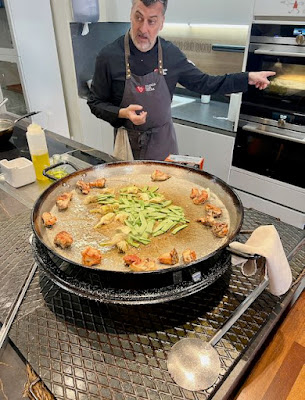 |
| Adding vegetables |
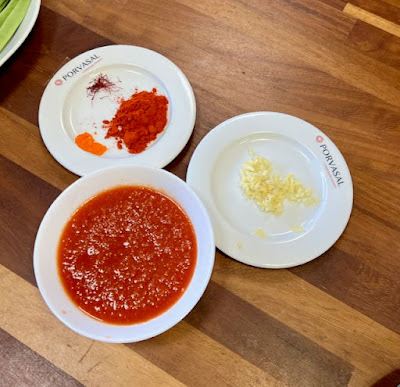 | |
| Adding spices |
 |
| Combining all the flavors |
 |
| Adding water |
 |
| Low heat and simmer |
Next assignment was the potato omelette
 | ||||||||||||||||||||
| Potatoes and onions for omelette |
 |
| Enjoying Sangria and Prochetta while cutting onions and potatoes |
 |
| Cooking the omelette |
 |
| Preparing a garlic/oil drizzle for the omelette |
Chef Luis articulated to us that Valencia proudly boasts eleven varieties of rice, each with its own unique characteristics. The history of rice cultivation in this Iberian nation traces back to the 8th century during the period of Moorish rule. The Moors, having honed the skills of rice cultivation from their Persian and Arab predecessors, introduced this precious grain to the fertile lands of the Spanish east coast, particularly the region of Valencia.
The traditional varieties of rice from Spain include:
- Bomba: A short grain, almost round rice, with a pearly color. It absorbs three times its volume in water as opposed to the average rice grain, which absorbs only twice its volume. This means it absorbs more flavor and does not stick together. For these reasons, bomba rice is highly prized by cooks. Another difference with the bomba variety is in the way it expands during the cooking process. Instead of cracking open along with the length of the grain, it breaks open crosswise and as it cooks it expands like an accordion until it reaches three times the length of the raw grain.
- Senia and Bahia: A short-grain rice variety similar to bomba in that they also absorb more than the average amount of liquid, and retain a creamy texture after cooking. They are the two most widely grown varieties of rice grown in Spain.

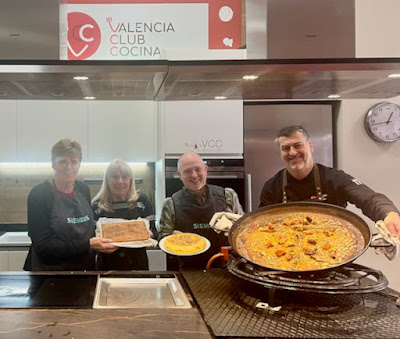
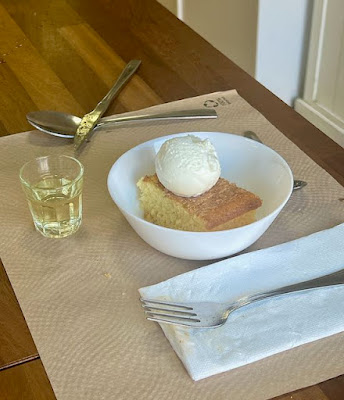


No comments:
Post a Comment